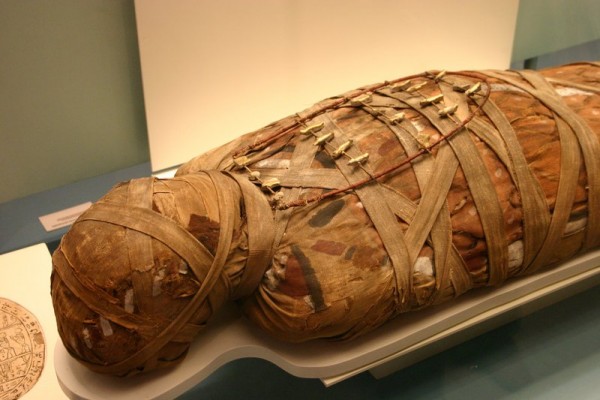3,000-year-old Mummy Found under HUSS
BY KANZY AMR MAHMOUD

The Egyptology department has confirmed that a 3,000-year-old mummy was discovered under the building of the School of Humanities and Social Sciences in 2011 but that announcement was delayed for political reasons on campus.
“That’s true, we couldn’t make the announcement because of what happened after we opened the sarcophagus of the 47th Dynasty King Hatwekhod,” said history professor Philipan Turn.
The Caravan has learned that the mummy of the ancient king was found with a sign written in hieroglyphics which roughly translated in English says “is the budget deficit over yet?”
AUC’s Office of Pennies and Accounts (OPA) immediately denied any knowledge of a deficit while the Student Union (SU) said it would hold a rally near the pyramids to “aware the people that the administration has been hiding many sarcophagi under all the schools and a treasure chest under AUC’s Tahrir Square Library to continue their claim to the deficit.”
The SU later announced that they will be going on a Scavenger Hunt on April 2 to dig up the buried treasures and will close the university gates if they have to.
The Caravan has learned that a professor who goes by theinitials Z.Z. Top will collaborate with the SU to organize the Hunt.
President Lisa Anderson has previously confirmed to The Caravan that AUC’s underground network of tunnels also doubles as a crypt, and several workers have been getting lost after wandering into the abyss.
Security supervisor Zaatar Shalawy said: “ [We] will not stand in the way of students. We will just record everything on our OPR (optical character recognition) and Panorama cameras and send it to the administration”.
An anonymous source at OPA, who refuses to share his name out of fear, disclosed exclusively to The Caravan that the deficit was created 3,500 years ago.
On his journey to Ancient Egypt one of the Iberian explorers Leihkid Ahwekidah loaned King Hatwekhod 500 small Karrag statues to fund his temple on the condition that he names it Hussus.
According to the source, Hatwekhod built the temple but was unable to repay the debt and it accumulated over the years.
Therefore, the Pharaoh asked one of his servants to put the note in his tomb so that later generations could inform his spirit when the deficit was over.
It remains unclear whether the tomb of King Hatwekhod contained treasures that could have been used to resolve the budget crisis.
[The above picture was republished under free use]
Editor’s note: We hope you enjoyed this article, one of several published to mark April Fools’ Day.



